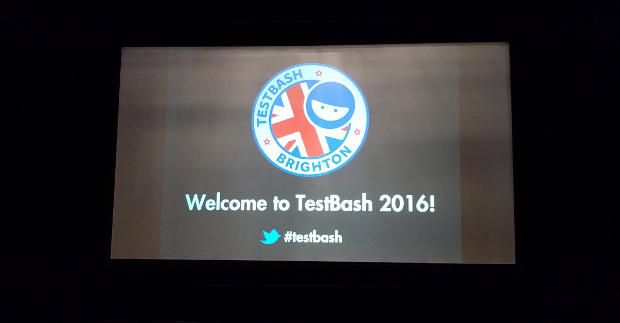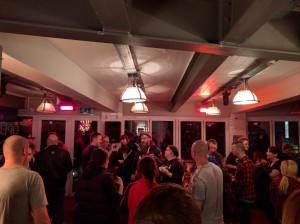I am just back home in Hamburg from one of the greatest testing conferences in the world which was taking place this week in Brighton /England and I am talking about Testbash. Last year I already had the chance to attend the conference and to provide a workshop about mobile testing. This year I was in the luxury situation of just listening to all the great speakers which were talking about testing. If you don’t know testbash or have never attend the conference you should really try to get there once. Testbash is not like any other software testing conferences out there. Testbash is all about the people and the testing community. There are no big sponsor booths, trying to sell you any kind of products you may not need, no the breaks are for you to meet and to talk to other software testers. The coffee breaks are used to make new contacts, to share experiences and to make new friends. However, there are not just the breaks to talk to people, there are so many pre testbash meetups at pubs, restaurants or in any other places where you can meet the conference people.
Daniel
Reading Recommendations # 53
The 53rd edition of my reading recommendations contains 7 interesting blog posts with various topics that might be of interest for you. This time there are post with the topics “Real Life Leadership”, “8 Tips for Successful Independent Consulting”, “Rhythm of Testing”, “What makes them Leaders I want to work with”, “Finding the best bug reporting tool”, “Is your testing well spread” and “Android Smartphone Test Farm”.
Enjoy reading the posts and send me new ones that are worth reading and I will mention you and link to your social links or blog.
 | Real Life Leadership – 6 Ideas That Really Work – Leadership Speaker David Dye |
| Source: trailblazeinc.com/real-life-leadership/ | |
Smartwatch App Testing – Android Wear
This is the 4th and last post of my smartwatch app testing series. However, there will be one more post with lots of testing ideas coming next week, so stay tuned for that. In this post I will write about Android Wear and the important features to know about this platform. Android Wear, as the name already suggest is based on Android and is developed by Google. The platform was launched at the Google I/O 2014.
Android Wear is written in C, C++ and Java and is open source like Android. The latest version based on Android 5.1.1 aka Lollipop (Version 6.0.1 aka Marshmallow is currently in roll-out stage). Since Android Wear is open source many manufacturers already produced their own Wear based watches. Some of you might think, yet another fragmentation challenge is coming up, but this is not the case for Android Wear. Google build this platform in a way that the UI is not customizable like Android for smartphones. The main goal is to get a common look and feel as well as features on different watches, produced by various manufacturers. This is a great step for all people working with wearable apps based on Android Wear, because it downsizes the amount of work.
[Reblog] Android Smartphone Test Farm
This post is a reblog from the XING developer blog. In the last week we had our quarterly HackWeek at XING. During the week I was working with some colleagues on a project to setup a Android Smartphone Test Farm based on openstf.io.
Excerpt from the original version:
Mobile is becoming increasingly important for companies that build web applications, and that also includes XING. Over 50% of our platform traffic comes from mobile devices. This in turn leads a constant increase in the complexity and amount of testing work required on mobile devices.
Our challenge
At the beginning of 2015 XING launched a new internal initiative called “Unleashing Mobile”. The idea behind it is to upscale mobile development from a single mobile team to multiple teams within the company. The previous team setup was simply not able to keep pace with the development speed of the web platform and bring more and more features to the Android, iOS and Windows Phone mobile platforms. As things stand, we have 5 mobile feature teams developing features like profile, jobs, content or messages. Besides that, each platform has a central core team divided up into a platform and framework sub-team. The core platform team works on features that haven’t yet been passed on to the domain teams. As well as building its own app features, the core team has adopted more of a consulting role in helping to keep the whole app consistent and clean. Another key task of the central core teams is to integrate all of the code changes every two weeks to make sure that a stable app version can be released to our users.
Reading Recommendations # 52
Welcome to the 52th edition of my reading recommendations! Since one year I am reading and collecting interesting posts about software testing, software development and sometimes posts that are not dealing with the main topics but may be of interest for you, too.
The anniversary edition contains 9 interesting blog posts with various topics that might be of interest for you and one youtube video which shows an awesome mobile automation robot. There are posts with the following headlines “Test Automation Sells”, “A bug that thaught that we’re implementing too much”, “Why We Struggle with Change”, “Testing Trapeze February Edition”, “Can we stop saying we break software”, “The new Testing Conference”, “How blogging can improve your testing”, “Do You Actually Know What Your Automated Test Is Doing?” and “The Importance of Acceptance Criteria”.
Enjoy reading the posts and send me new ones that are worth reading and I will mention you and link to your social links or blog.
| Test Automation Sells | Hello Test World Somewhere I saw a statement that testing today is about 25% of IT budgets with a tendency to increase. Not sure if that’s true but even half of that is a lot of money. So of course managers and financial controllers are looking where they can eek out any spare $s. Because testing and quality… | |
| Source: hellotestworld.com/2016/02/18/test-automation-sells/ | |




